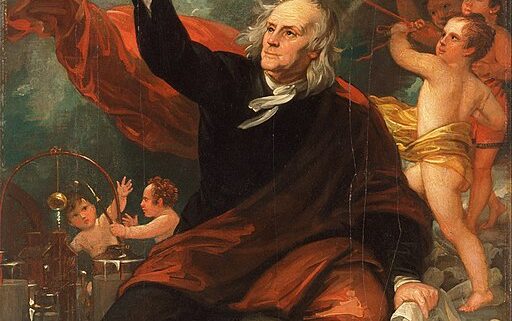Franklin in Portraits: Benjamin West
To accompany our virtual exhibition, Franklin in Portraits, join us for the second in a series of talks about Benjamin Franklin’s most famous portraits over the years. Find the exhibition on the free Bloomberg Connects app.
This portrait commemorates Benjamin Franklin’s famous kite and key experiment and the invention of the lightning rod but was painted after Franklin’s death in 1790. It was originally meant to be part of a larger piece for the Philadelphia Hospital, an institution founded by Franklin. West met Franklin when he was in London as the second president of the Royal Academy of Arts.
Dr George Boudreau is a cultural historian of early Anglo-America, specializing in the history of Philadelphia, the work of Benjamin Franklin, material culture, and public history. Boudreau was the founding editor of the journal Early American Studies, and has won six major grants from the National Endowment for the Humanities. He was a fellow at Fred W. Smith National Library for the Study of George Washington in 2019-20 and has previously completed fellowships at the Jamestown Rediscovery and the Omohundro Institute for Early American History and Culture at Williamsburg, the International Center for Jefferson Studies at Monticello, the Library Company of Philadelphia, Winterthur Museum and Library, the American Philosophical Society, and the David Library of the American Revolution. A 1998 Ph.D. from Indiana University, he is currently senior research associate at the McNeil Center for Early American Studies at the University of Pennsylvania and is a member of the Academic Advisory Panel for Benjamin Franklin House.
Carol Eaton Soltis is Project Associate Curator in the Philadelphia Museum of Art’s Department of American Art. Focusing on its collection of antebellum portraiture and portrait miniatures from the 18th to the 20th century, she also oversees the museum’s remarkable collection of the art by America’s first artistic dynasty, the Peale Family.
She received her doctorate in the History of Art from the University of Pennsylvania with a dissertation titled, “‘In Sympathy with the Heart,’ Rembrandt Peale, an American Artist and the Traditions of European Art.” As author of the first substantive catalogue and exhibition on Rembrandt Peale, Rembrandt Peale, A Life in the Arts (Historical Society of Pennsylvania), she later joined the Smithsonian’s Peale Family Papers, where she assembled a catalogue raisonné of Rembrandt’s work and co-curated the National Portrait Gallery’s exhibition, Rembrandt Peale, 1778-1860, In Pursuit of Fame.
Her most recent book, The Art of the Peales, Adaptations & Innovations, published by Yale University Press, is an in-depth catalogue of PMA’s unparalleled Peale Collection, which contains oil portraits, watercolor on ivory miniatures, still life pictures, landscapes, drawings and prints by fifteen different Peale artists spanning the 1770’s into the 20th century. Written as a narrative, to highlight the connections between the individual artists and their work, it was honored in 2018 by The Athenaeum of Philadelphia as an “outstanding work of non-fiction by a Philadelphia author.” Her most recent article, “Yarrow Mamout and the Charles Willson Peale Portrait of 1819,” appeared in The Muslim World, A Journal Devoted to the Study of Islam and Christian-Muslim Relations, Special Issue: Black Muslim Portraiture in the Modern Atlantic, Guest Editor, Zain Abdullah, v. 110, no. 3 (Summer 2020).
Aside from lectures and articles on a variety of nineteenth century American artists, she co-curated and co-authored the exhibition and catalogue, Thomas Sully, Painted Performance (Milwaukee Art Museum and Yale University Press, 2013). The first major exhibition of Sully’s work in thirty years, it examined his portraiture in the context of his life-long interest in the theatre and integrated his subject pictures into a consideration of his career and artistic production.
As part of the team that has been working on the re-interpretation and dramatic re-installation of PMA’s new American galleries prior to 1840, she is anxious for their scheduled opening this May. Dr. Soltis has served as a trustee of the Historical Society of Pennsylvania and is a trustee emerita of the Library Company of Philadelphia, which was founded by Benjamin Franklin in 1731. She is also a partner in the digital database project, Reconstructing Philadelphia’s Earliest Museums, 1774-1827 with Dr. John Van Horne, Emeritus Director of The Library Company of Philadelphia. Their project will document the contents of the museums of Pierre Eugène Du Simitière and Charles Willson Peale and is hosted by the American Philosophical Society, another Philadelphia Institution founded by Franklin (1743).


